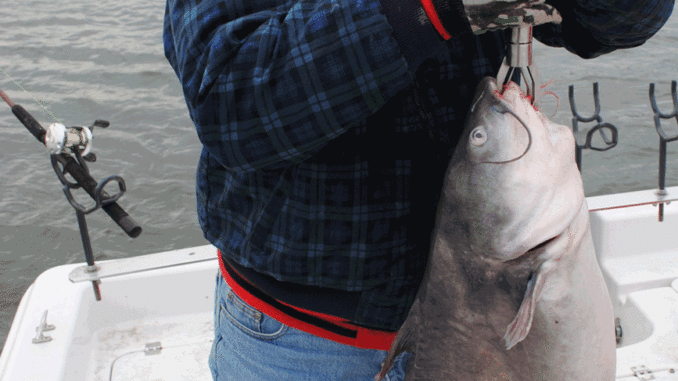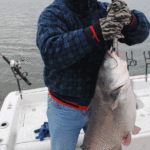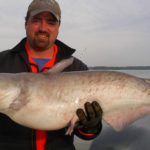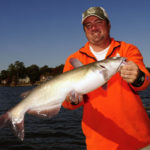
Big blue catfish are no match for in-the-know fishermen as the late fall and winter bite kicks off.
It was still dark when Ed Robinson and guide Chris Simpson met for a catfishing trip to Lake Monticello.
It was a cold, crisp morning, with the frost shining in the grass like little diamonds and a predicted high temperature in the low 40s — a typical South Carolina day, as winter starts to creep up on autumn.
Robinson, who runs Ed’s Curb Appeal in Belton, met Simpson when he called him for advice; he’d fished Monticello several times but had caught only small blue cats.
The tips the guide provided worked, and Roberson decided first-hand experience might help even more; one trip turned him into a regular customer of Simpson’s Fightin’ da Blues Guide Service. Subsequent trips produced a 58-pound, 13-ounce blue that’s the biggest Monticello cat to come over the gunwales of Simpson’s 19-foot center console.
“Monticello is completely loaded with blues of all sizes,” Simpson said. “It comes down to what you want to target.”
Simpson got the boat planed out with little trouble, heading to some of the underwater ridges that had held fish, but despite concentrations of baitfish on his depth recorder, Simpson didn’t see any of the big arcs that indicated feeding catfish. He headed for an area near the mouth of a creek that was filled by baitfish, and that turned out to be the ticket.
Simpson put out six rods and started drifting, the speed controlled by the boat’s trolling motor and a wind sock. The first strike came 100 yards into the drift, followed by another, and by the end of the first drift, three “teenagers” were in the boat, anchored by a 17-pound fish.
Fresh baits were the order all around before the second drift, which netted two nice channel cats. The third drift produced two more channel cats and another teen-aged blue, and the fourth drift added two more channel cats. The fifth drift added two more teenagers to the larder, and by the end of the trip, Roberson had eight blues between 14 and 18 pounds, plus nine more channels in the neighborhood of two pounds. He released the blues and kept the channels for a huge family fish fry he had planned: deep-fat tried catfish nuggets, cole slaw, hush puppies, grits and iced tea.
Simpson said 4 pounds is a solid, average channel cat from Monticello. And 10- to 15-pound blues are the norm, although some truly huge fish inhabit the 6,800-acre lake. The biggest blue caught from Monticello thatSimpson has personally seen weighed 80 pounds.
Simpson’s favorite bait during colder months is a big gizzard shad, anywhere from eight to 12 inches long. He usually cuts the baitfish into three parts: head, middle and tail sections. He’ll also fish filets cut from the side of the shad, leaving some bones in the side for best results. He’ll also fish bream, and another favorite bait is cut white perch; the head section seems to catch the biggest blues.
When Simpson sees concentrations of perch on his graph, he drops a quarter-ounce spoon to the bottom and jigs it with short up-and-down jerks, often producing enough perch to fish as fresh bait for an entire trip.
The bait he fishes is often dictated by what he wants to target.
“You can catch a few fish, but bigger fish, or you can catch numbers of whatever size you catch,” he said. “These days, I usually fish for big fish. You catch a big fish, a few teenagers, or nothing at all.
“For big fish, I like to use tough baits: white perch, bream and big gizzard shad. I don’t necessarily cut them into big pieces, but the toughness of those baits keeps the half- to 5-pound fish from tearing off the bait while you wait for a big fish.”
With big fish a distinct possibility, Simpson make sure he’s got heavy-enough tackle. He likes to fish a 7-foot rod with a stiff butt and medium tip, paired with an Ambassador 5000 level-wind reel with a smooth drag, spooled with 25- to 30-pound test line.
When drifting, he uses a standard Santee drift rig, several feet of 50-pound test tied below a swivel, with a 2- to 3-inch crappie cork 8 to 10 inches above the 8/0 Gamakatsu circle hook on the business end. He likes a “slinky” type swivel made from parachute cord with a snap swivel at one end to slide on the running line above the barrel swivel.
When he anchors and fishes, which is often a winning technique in the winter, Simpson will use anchors fore and after to keep his boat still and will fan-cast up to 10 rods around the boat to cover multiple depths.
DESTINATION INFORMATION
WHEN TO GO/HOW TO GET THERE — Lake Monticello is a 6,800-acre lake in Fairfield County north of Jenkinsville and west of Winnsboro. It lies between I-26 and I-77 and can be accessed from either highway via SC 213. The lake has two public boat ramps, one just south of the SC 99 bridge on the lake’s upper end, and just north of Lake Monticello Park off SC 215 on the lake’s southeastern bank. Catfishing is excellent year-round, with good fishing for channel cats and blue cats early in the fall, with big blues really showing up around Thanksgiving and through the winter.
TECHNIQUES/TACKLE — Fairly heavy baitcasting or spinning tackle is recommended. When drifting, a Santee-style drift rig with a “slinky” type weight above the leader and a small float threaded on eight to 10 inches above the 8/0 circle hook. For anchoring, a Carolina rig with a 2- or 3-ounce egg sinker threaded above the swivel, with an identical leader situation tied to the other end of the swivel.
FISHING INFO/GUIDES— Chris Simpson, Fighting da Blues Guide Service, 864-992-2352 or http://www.fightindablues.com/. For info, see www.lakemonticellofishing.com. Also see GUIDES & CHARTERS in Classifieds.
ACCOMMODATIONS — Fairfield Motel, US 321 by-pass, Winnsboro, 803-635-5559.
MAPS — Kingfisher Maps, 800-326-0257 (Ext. 1) or www.kfmaps.com.




Be the first to comment